Kenya is home to more than 40 tribes, each with its own unique traditions and cultural practices.
That means the country barely has a national dress code that can summarize or characterize the diverse traditions, ethnic preferences, or cultures as a whole.
Therefore, while the vast majority of modern-day Kenyan attire borrows heavily from Western fashion, including clothing pieces like skirts, jeans, shorts, blouses, dresses, and trousers, attires with a hint of tradition remain quite popular, especially during ceremonies and major inter-community or national events.
This shows how Kenyans value traditions and have always taken pride in their history and culture.
Traditional Tribal Clothing
Different tribes in the country have adopted different clothing types for various purposes over the years, but tradition remains the cornerstone.
For the most part, Kenyan women typically cover their bodies with lesos, while men – especially those from pastoral communities – use “shukas”.
Elders and folks in authority traditionally wear specially designed dress codes alongside fancy jewelry to symbolize power.
While it can be difficult to identify all Kenyan tribes at a glance based on their clothing, here are 12 easily recognizable traditional attire of a few prominent Kenyan tribes.
1. Kanga
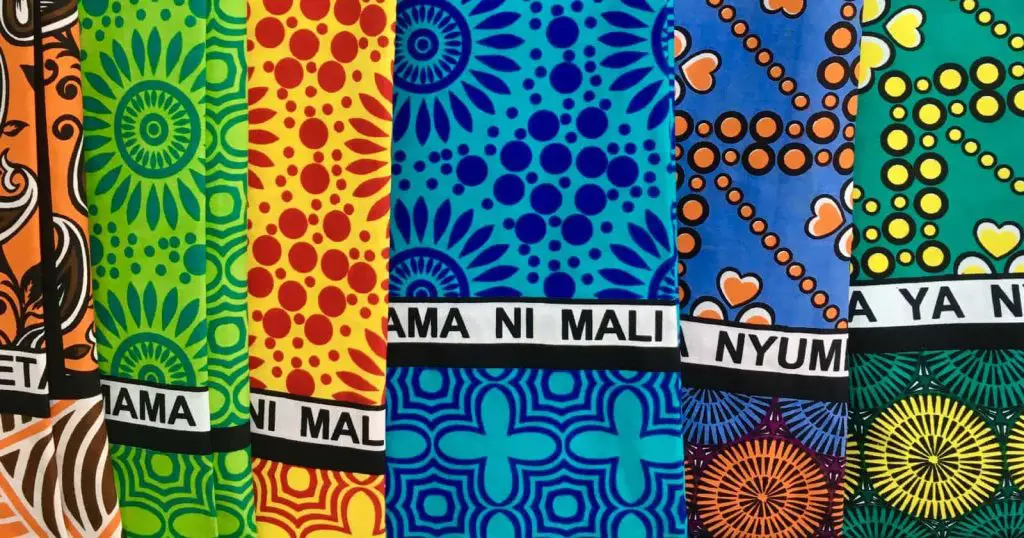
The kanga is a colorful rectangular cloth worn by women from various ethnic groups in Kenya, especially the Swahili, Mijikenda, and Luo.
It is usually wrapped around the waist or chest, or used as a headscarf, shawl, or baby carrier.
The kanga often has a border and a central motif with a Swahili proverb or message printed on it.
The kanga is a versatile and expressive garment that can convey different meanings depending on how it is worn, folded, or tied.
Also Read: Where to Buy Kangas in Nairobi
2. Kitenge
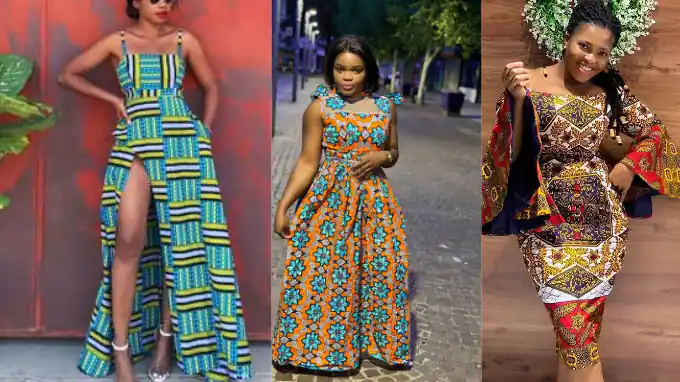
The kitenge is similar to the kanga, but it is made of thicker fabric and has more elaborate patterns and designs.
It is also worn by women from different ethnic groups, but it is more common among the Kikuyu, Luhya, and Kamba.
The kitenge can be tailored into dresses, skirts, blouses, jackets, or trousers, or used as accessories such as bags, hats, or jewelry.
The kitenge is a fashionable and creative garment that showcases the artistic skills and tastes of its wearers.
3. Shuka
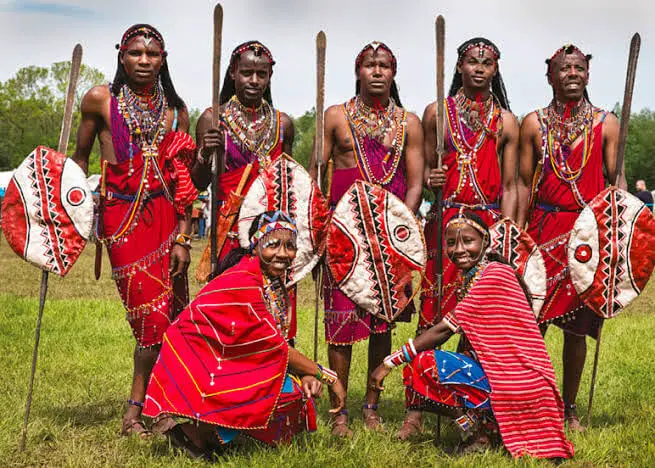
The shuka is a red-and-black checked cloth that is worn by the Maasai people, who are known for their pastoralist and warrior lifestyle.
The shuka can be worn by both men and women, either as a wraparound skirt or a cloak over the shoulders.
The shuka is a symbol of the Maasai identity and pride, and it also serves as protection from the harsh weather and wildlife of the savanna.
4. Kikoi
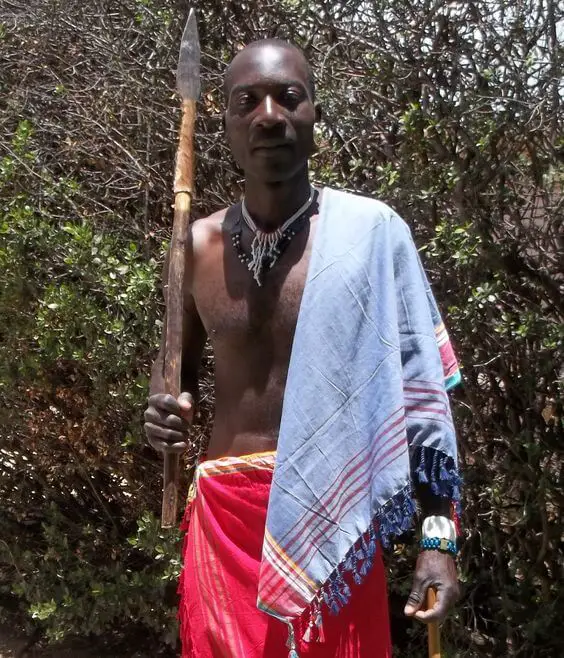
The kikoi is a striped cotton cloth worn by men from the coastal regions of Kenya, such as the Swahili, Mijikenda, and Taita.
It is usually wrapped around the waist like a sarong or tied over one shoulder like a toga.
The kikoi can also be used as a towel, a blanket, or a curtain.
The kikoi is a casual and comfortable garment that suits the warm and humid climate of the coast.
5. Hando

The hando is a traditional attire worn by Mijikenda women in Kenya.
It is made of short cotton ropes that are tied to the waist using a string.
The hando comes in different colors, such as white, red, and blue, which signify different statuses or roles in society.
The hando is a symbol of identity and pride for the Mijikenda culture, and some women still wear it on special occasions or as a fashion statement.
6. Mulia
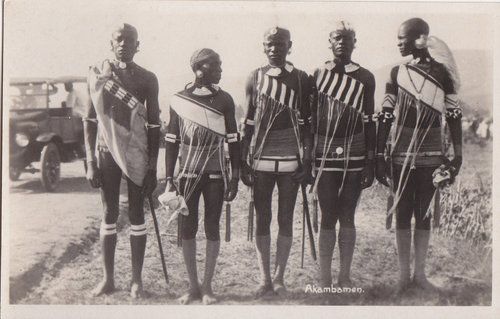
Mulia is a spiral wire vest that young Kamba men wear around their lower body parts.
It is part of the traditional Kamba attire and jewelry that varies depending on the occasion.
Mulia is made of metal and sometimes decorated with beads.
7. Githii
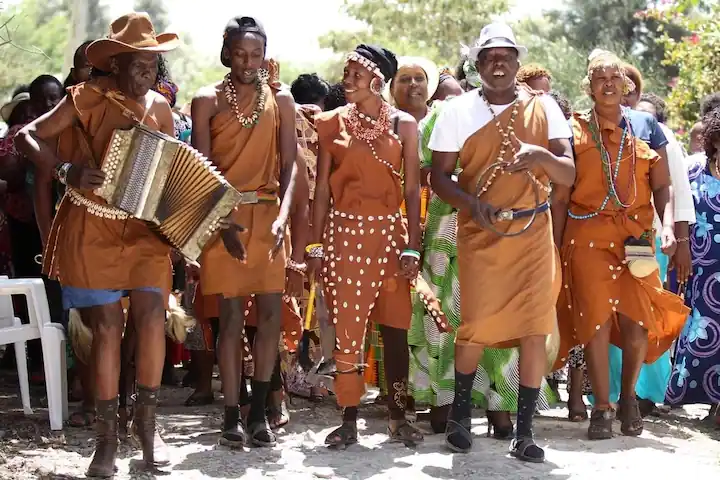
Githii is a traditional attire worn by Kikuyu men during special occasions, such as cultural ceremonies.
It is made from animal skin, usually cow or gazelle, and decorated with beads and cowrie shells.
Githii is a cultural attire, therefore, you are likely to see noticeable differences between those worn by senior members of the community and young people.
The young wear short githiis while the elderly wear long ones with fur coverings.
8. Nyathiba
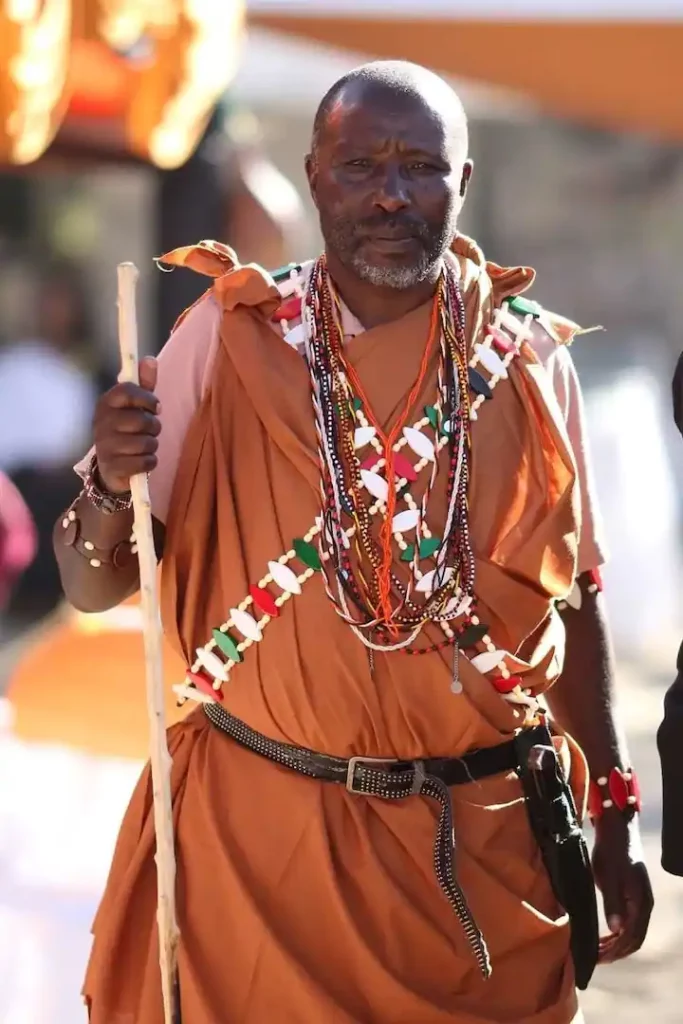
This Kikuyu traditional attire is made from tanned, dried, and dyed skins which are decorated with beads and cowrie shells to create different patterns and designs.
Men wear a leather cloak called Nyathiba, which covers their shoulders and chest. They also wear a leather belt called Muguro, which holds their knife and other tools.
The Kikuyu traditional attire is worn mostly during cultural ceremonies, such as weddings, dowry payments, and rites of passage.
The attire varies depending on the age, gender, occasion, and ceremony of the wearer.
9. Miniuru
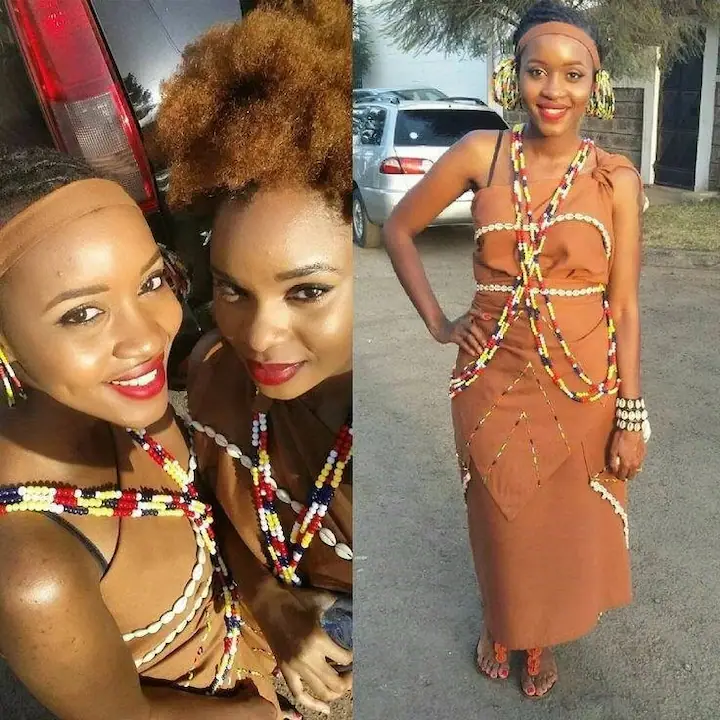
Miniuru is another Kikuyu traditional attire worn by women after initiation.
It is a fully beaded apron that covers the front part of the body and is usually paired with a leather wrap-around skirt called a muthuru.
The miniuru is a symbol of maturity and fertility, and it is often decorated with cowrie shells and other ornaments.
The miniuru is one of the most distinctive and elegant designs of Kikuyu culture, and it reflects the skill and creativity of the Kikuyu women who make them.
10. Kanzu
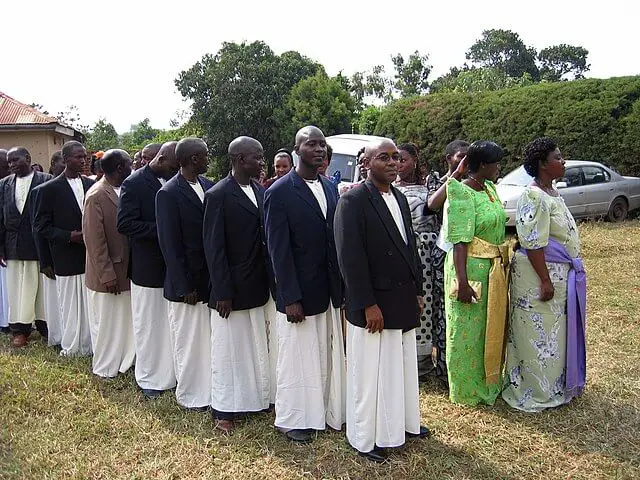
This is a white or cream-colored robe worn by men especially, the Swahili along the coastal parts of Kenya.
It is similar to the Arabic thowb but has some distinctive features, such as a tassel that hangs from the collar, and embroidery around the collar, abdomen, and sleeves.
11. Dashiki

Dashiki is a distinctive and loose-fitting traditional West African attire characterized by its bright colors and intricate patterns.
Made from cotton fabric, it showcases flowing sleeves and a relaxed fit.
Originally from West Africa, Dashiki has gained popularity beyond its roots and has become a fashionable choice in Kenya as well.
Its vibrant designs and cultural significance make Dashiki a stylish statement of African heritage and a symbol of fashion fusion across borders.
12. Gomesi
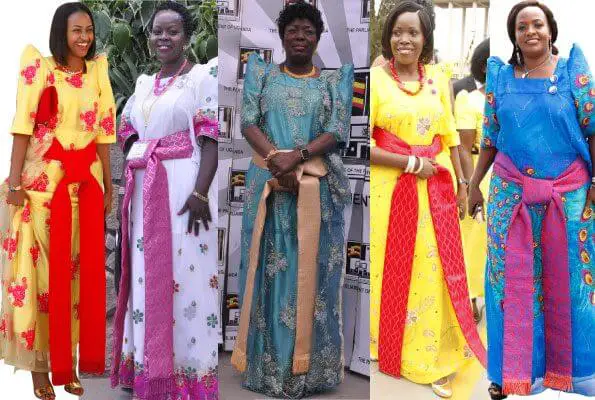
The gomesi is a type of traditional clothing commonly worn by women from the Luhya people, who live in the western part of Kenya.
The gomesi is a long dress that has a square neckline, puffed sleeves, and a sash around the waist.
The gomesi can be made of cotton, silk, or satin fabric, and can have different colors and patterns.
The gomesi is worn on formal occasions, such as weddings, funerals, or church services.
Like the Dashiki, the Gomesi does not originate from Kenya but instead has its roots in Uganda, particularly among the Baganda women.
However, the Gomesi has gained widespread popularity and is now embraced by people in Western Kenya and beyond, transcending geographical boundaries.
Other Notable Accessories
Kofia
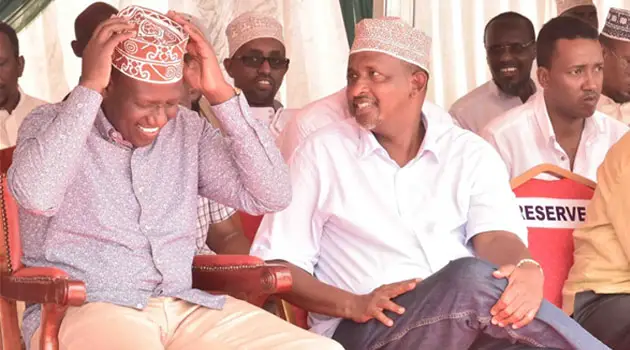
The kofia is a type of cap worn by men from various ethnic groups in Kenya, especially the Swahili, Somali, and Borana.
It is made of cotton or wool fabric, and it can have embroidery or crochet on the top of the rim.
The kofia can be worn with a robe or a suit, and it can have different colors and styles depending on the occasion.
The kofia is a formal and respectful headwear that signifies the Islamic faith and culture.
Akala
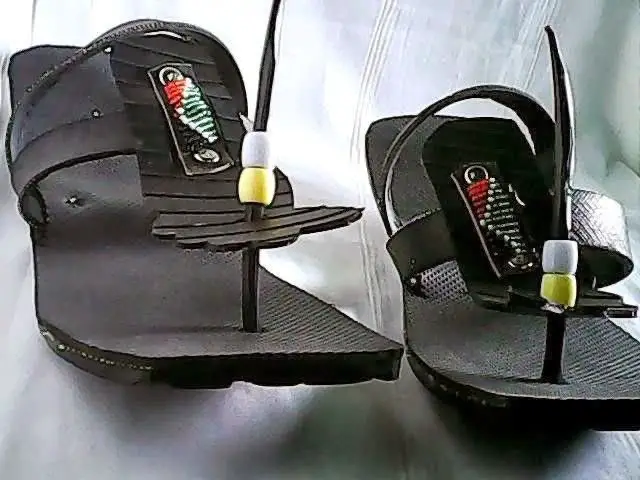
The Akala is a type of sandal made from recycled car tires by men from the Maasai ethnic group in southern Kenya.
It can have different designs and decorations such as beads, shells, or metal studs.
The Akala is a sturdy and eco-friendly footwear that protects the feet from the rough terrain and thorns of the savanna.
Beaded Jewellery

Beaded jewelry is a common form of adornment among many ethnic groups in Kenya, such as the Maasai, Samburu, Turkana, Pokot, and Kikuyu.
They include necklaces, bracelets, earrings, belts, anklets, or headbands.
Beaded jewelry can have different colors, shapes, sizes, and meanings depending on the tribe, gender, age, and status of its wearer.
Beaded jewelry is a beautiful and symbolic way of expressing one’s identity and personality.
Kiondo
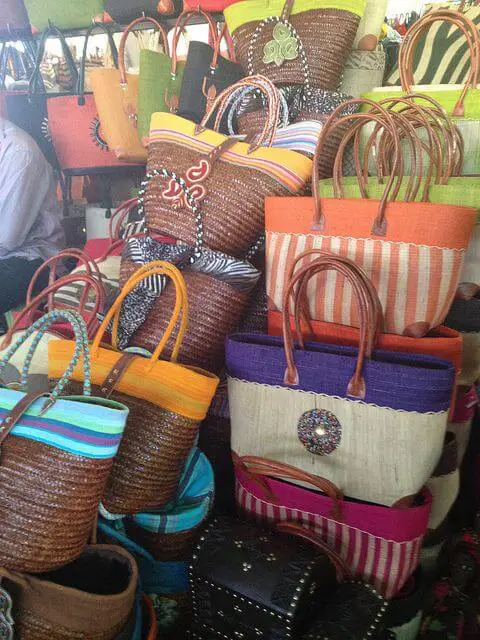
The kiondo is a type of basket woven from sisal fiber or leather strips by women from the Kikuyu ethnic group in central Kenya.
It can be used as a handbag, a shopping bag, or a storage container.
The kiondo can have different shapes, sizes, colors, and patterns depending on the preference of its maker.
The kiondo is a functional and durable accessory that showcases the Kikuyu weaving skills and creativity.
Where to Buy Authentic Traditional Kenyan Clothing
When it comes to finding traditional Kenyan clothing, there are several options available both online and in physical marketplaces.
Online platforms like Amazon and Etsy offer a wide range of choices, allowing you to explore and purchase traditional Kenyan garments from the comfort of your own home.
For a more immersive shopping experience, visiting Maasai markets, Toi Market, and City Market in Kenya is highly recommended.
These vibrant markets showcase an array of traditional Kenyan clothing, including colorful Maasai shukas, kikois, khangas, and various tribal-inspired garments.
The markets allow you to interact directly with local artisans and vendors, enabling you to learn about the cultural significance behind each piece and negotiate prices.
If you prefer the convenience of online shopping, popular Kenyan online retailers like Jumia Kenya, Kilimall, Nairobi Textiles, Nida Textiles, and Terica Fabrics offer a diverse selection of traditional Kenyan clothing.
These platforms provide a convenient way to browse through different designs and styles, making it easier to find the perfect traditional Kenyan attire that suits your preferences.
You may also want to check: 9 Fascinating Kenya Food Traditions You Probably Didn’t Know
